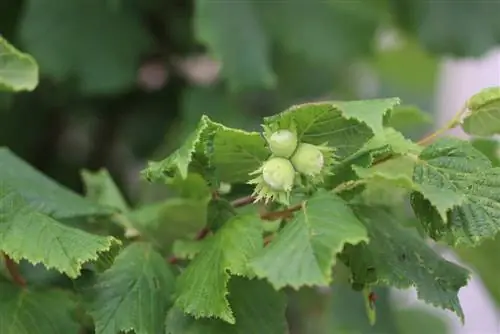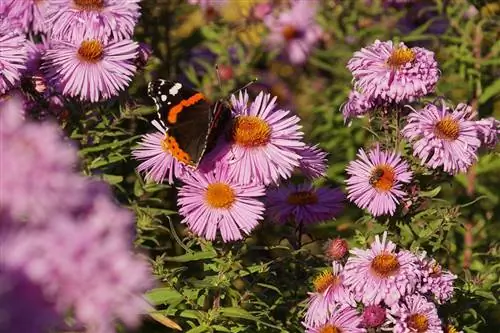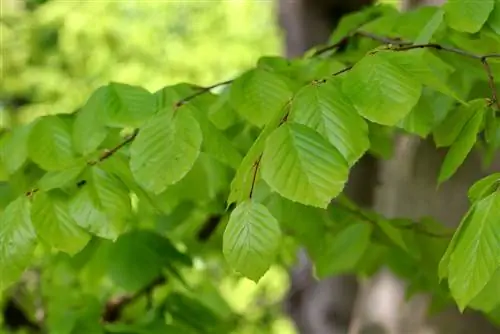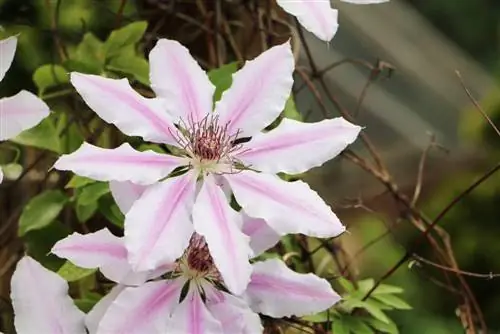- Author admin [email protected].
- Public 2023-12-17 03:39.
- Last modified 2025-01-24 12:45.
Hazelnut bushes require little care - but a lot of space. The strong and robust tree can grow into a powerful large shrub in just a few years. A hazelnut fits perfectly into freely designed hedges and fits perfectly into any large natural garden.
Hazelnuts are unsuitable as an ornamental shrub for small gardens. Unless your neighbor is as enthusiastic about the tree as you are and you use the plant as a privacy screen on the shared property line.
Profile
- Botanical name: Corylus
- Shrub form: Corylus avellana (common hazel, hazelnut bush, hazel bush)
- Tree form: Corylus colurna (tree hazel, Turkish hazel)
- fast growing (shrub up to 6 m, tree up to 20 m)
- deciduous, usually multi-stemmed shrub, rarely as a tree
- Flowering: catkins, from February
- Fruits: round or oval nuts in autumn
Basic rules for shrub pruning
The basic requirement for cutting a shrub is knowledge of the natural growth characteristics of the tree. There are also a few rules for cutting that need to be observed.
- clean, sharp cutting tool
- Always cut shoots directly at the point of origin
- cut a little, but carefully
- cutting only the tips means: balding of the base of the bush and broom growth
- Lighting occurs at the base
- Removing old shoots (hanging downwards) to young shoots
Cutting tools
- Hand scissors
- Two-handed pruning shears
- Saw (tree saw or hand chop saw)
- for taller hazelnut trees also use cutting giraffes or telescopic scissors
Different types of cuts
Cutting is not the same as cutting: A distinction is made between planting pruning, pruning to build up the wood, maintenance pruning and rejuvenation pruning.
Plant cutting
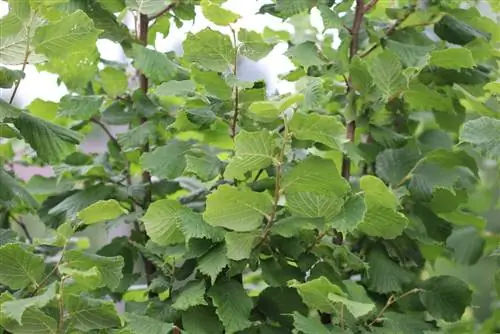
Before the newly purchased hazelnut is planted in the ground, damaged roots must first be shortened and the above-ground shoots removed (only necessary in spring or summer). This measure ensures better growth, prevents diseases and protects against excessive evaporation through the leaves while the tree gets used to its new environment. Shorten shoots by about a third.
Build-up cut
For a young plant, regular pruning is necessary in the first few years, which supports the hazelnut tree in its development into a natural habit. This cut was usually carried out for the first time in the tree nursery. To do this, one central main shoot is left a little longer and the rest are cut into a slightly spherical shape. In spring, all but two or three new basal shoots should be cut. The structure ends at around 10-12 stems. These new shoots should be nicely evenly distributed across the plant.
Conservation cut
Dense, fast-growing shrubs like hazelnuts tend to become bald inside. In order to keep the shrub blooming and vital, dry or dead branches are removed from adult trees. Every two to three years, old shoots are cut close to the ground and the same number of young ones are left standing.
- Time: February to March
- Cut back shoot tips of some branches
- for younger trees about 15 cm
- for older trees up to 50 cm
- always cut over an outward-facing eye
- maintain characteristic growth habit
- distribute all cuts evenly over the tree
Tip:
At this point, something can also be done for the he alth of the shrub or tree. Remove any inward-growing shoots and dead or crossing branches. This brings additional air inside and protects against diseases.
Rejuvenation cut
If the hazelnut tree is already getting old - possibly without pruning - the gardener has to take a more radical approach. The measure is carried out gradually so that the entire plant does not have to be razed to the ground. Before cutting, take a close look at your hazelnut. It's no use just making cosmetic corrections to the outer branches; the inside also needs to be cut back.
1. Year
In the first year, cut back about a third of all branches to about 40 centimeters above the ground. A few buds must still remain on the shoot. To ensure that the tree grows beautifully spherical after new growth, always cut directly above an outward-facing eye. Distribute all cuts evenly over the hazelnut bush. Time: October to March (during hibernation).
2. Year
In the coming winter season it will be the turn of the second third of shoots. Only those branches that were not shortened the previous year are cut.
3. Year
Cut any remaining untrimmed branches. After the third year the shrub is completely rejuvenated.
Tip:
Cut out a few older shoots from the inside of established hazelnut bushes every year. So the shrub grows more like a wide bush and a lot of sunlight falls inside.
Blending cut
While a hazelnut bush is simply cut relatively close to the ground for rejuvenation, this is not possible with a tree without consequences. Here too, pruning in the winter months makes sense as the branches are now clearly visible. First of all, weak, diseased, dead and too dense shoots should be completely cut off. The following shoots must also be removed:
- Root shoots: these are the shoots that grow new in the lower trunk area
- Excess side shoots: The branches should preferably emerge from the trunk at regular intervals once on the right and once on the left. If two branches have grown on one side, either the thinner one or the one whose distance does not fit is removed completely.
- Water shoots: these are all the shoots that grow steeply upwards from the trunk or branches
- crossing branches
- branches growing too densely
Hock rash
Many cultivated forms of hazelnuts are refined. When cutting, it is important to ensure that the entire tree below this grafting point is not accidentally cut off. The hazelnut is also prone to canker sores. Shoots form at the base, which can reach several meters high in the first year and only branch out in the second year. They are easy to recognize and must be cut off at the base as they rob the tree of its strength for flowering and fruit production.
Corkscrew Hazel
Corkscrew hazels (C. avellana 'Contorta') are usually grafted onto the trunks and roots of insensitive related species. A gardener must keep a particularly careful eye on this decorative form throughout the year. It tends to have completely straight branches growing from the base of the plant (or grafting site). These quickly overgrow the actual corkscrew hazelnut and must urgently be cut off directly at the origin.
Hazelnut hedge
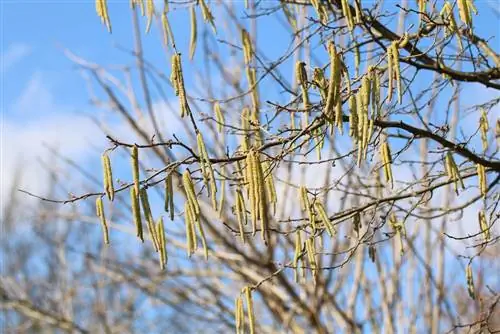
Hazelnut hedges are rejuvenated every few years. The thick shoots are removed close to the ground to make room for young shoots. This way they can grow better. You have to be careful not to damage the bark of the young shoots.
Conclusion
A hazelnut needs to be cut regularly, both as a shrub and as a tree. It is important to thin out the interior of the wood as well. This is the only way he althy and targeted growth is possible. While some of the many thin trunks of shrubs are cut close to the ground, the shape of the tree should be treated similarly to a fruit tree when cutting.
What you should know in brief
- The hazelnut tapers from the base. Preservation pruning is carried out on these trees.
- Flowering rotten, dead shoots and about 1/3 of the old shoots are removed at the base. This gives the young shoots space to develop.
- This cut is carried out every two to three years, then the bushes remain blooming and vital.
- Cutting the hazelnut is easy. Any beginner can do it. The wood forgives pretty much everything.
- It is best to cut out older shoots very close to the ground and otherwise only cut branches and twigs for shaping.
- With the hazelnut tree, make sure that no fresh shoots grow from the trunk or the ground. These shoots must be removed.
- The right time for pruning is from late winter to early spring, i.e. before the start of the growing season.
- In spring you have an overview because there are no leaves covering the branches and the wood is relatively dry.

